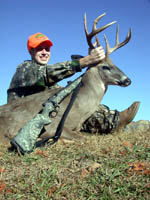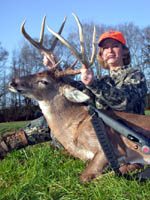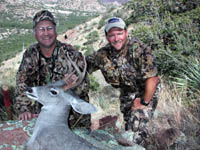
|
Features
|
|
|
|
Books
|
|
|
|
Fun & Games
|
|
|
|
Contact Us
|
|
|
John's Journal... Entry 222, Day 5
FIVE MOST CRITICAL INGREDIENTS FOR BAGGING A BUCK WITH A GUN
Ronnie Groom -- The Rut
 Editor's
Note: The five most-critical ingredients for taking a buck with your gun
at any time during the season include the wind, the weather, hunting pressure,
food availability and the rut. Most hunters will tell you one of these
factors has more importance to successful deer hunting than any other
element. However, you'll need to consider all these ingredients to develop
a successful hunt plan. This week we'll talk with some of the nation's
best gun hunters about their ideas. Ronnie Groom, of Panama City, Florida,
the owner of C & G Sporting Goods, takes several nice-sized bucks
each season with his gun, his bow and his black-powder rifle. If a slingshot
season exists anywhere, Groom will probably hunt that state with that
weapon too.
Editor's
Note: The five most-critical ingredients for taking a buck with your gun
at any time during the season include the wind, the weather, hunting pressure,
food availability and the rut. Most hunters will tell you one of these
factors has more importance to successful deer hunting than any other
element. However, you'll need to consider all these ingredients to develop
a successful hunt plan. This week we'll talk with some of the nation's
best gun hunters about their ideas. Ronnie Groom, of Panama City, Florida,
the owner of C & G Sporting Goods, takes several nice-sized bucks
each season with his gun, his bow and his black-powder rifle. If a slingshot
season exists anywhere, Groom will probably hunt that state with that
weapon too.
 The
rut marks the most-critical time of the year to bag a big buck with a
rifle. During the rut, big bucks will show themselves in open places where
you may never had seen them before and they may make stupid mistakes.
To bag a buck during the rut, go back to the sites where you've taken
a buck in years past during the rut. I've learned bucks generally like
to breed in specific areas year after year. However only hunt these spots
during the rut for the most success. A prime place to look for rutting
bucks is open areas adjacent to thick-cover regions. Then if the deer
sense danger at their scrapes they can get into that cover quickly. In
Florida where I hunt, during most of the season bucks like to stay in
the palmetto swamps. However, if I can locate an oak ridge running into
a palmetto swamp, then I usually will find a buck along that ridge during
the rut. During the rut, hunting in the middle of the day may produce
just as much success as hunting early in the morning or late in the afternoon.
Last year during the rut, I took a nice-sized buck pawing a scrape at
1:15 p.m. At any other time of the year, that buck probably would have
worked that scrape only at night. When the rut's on, you often can go
to a place where you've seen a buck, sit in that same spot and more than
likely that buck will come through that area that day or within the next
day or two. The rut makes bucks much easier to pattern. When you hunt
a rutting site, always watch for does. Most of the time does will tell
you when a buck is approaching by the way she acts by either running,
walking or acting nervously and looking over her shoulder. During the
rut, always carry a grunt call. If the buck comes close to your stand
catching a doe, blow your grunt call to stop the buck before he runs past
your stand.
The
rut marks the most-critical time of the year to bag a big buck with a
rifle. During the rut, big bucks will show themselves in open places where
you may never had seen them before and they may make stupid mistakes.
To bag a buck during the rut, go back to the sites where you've taken
a buck in years past during the rut. I've learned bucks generally like
to breed in specific areas year after year. However only hunt these spots
during the rut for the most success. A prime place to look for rutting
bucks is open areas adjacent to thick-cover regions. Then if the deer
sense danger at their scrapes they can get into that cover quickly. In
Florida where I hunt, during most of the season bucks like to stay in
the palmetto swamps. However, if I can locate an oak ridge running into
a palmetto swamp, then I usually will find a buck along that ridge during
the rut. During the rut, hunting in the middle of the day may produce
just as much success as hunting early in the morning or late in the afternoon.
Last year during the rut, I took a nice-sized buck pawing a scrape at
1:15 p.m. At any other time of the year, that buck probably would have
worked that scrape only at night. When the rut's on, you often can go
to a place where you've seen a buck, sit in that same spot and more than
likely that buck will come through that area that day or within the next
day or two. The rut makes bucks much easier to pattern. When you hunt
a rutting site, always watch for does. Most of the time does will tell
you when a buck is approaching by the way she acts by either running,
walking or acting nervously and looking over her shoulder. During the
rut, always carry a grunt call. If the buck comes close to your stand
catching a doe, blow your grunt call to stop the buck before he runs past
your stand.
 Don't
shoot the first buck you see most of the time because you may see more
than one buck -- sometimes three or four -- chasing a doe. Often a little
buck will come right behind the doe. Then you'll see a larger buck with
his nose down and his ears back moving along the same trail looking for
the doe. I also have found success at any time of day using mock scrapes
to attract bucks during the rut. When I make a false scrape, I use doe-in-estrus
scent and some form of dominant-buck lure. If I make eight or 10 mock
scrapes, often bucks will work five of those scrapes. Always stay downwind
of the scrapes and out of the bucks' sight and hearing to bag a buck during
the rut.
Don't
shoot the first buck you see most of the time because you may see more
than one buck -- sometimes three or four -- chasing a doe. Often a little
buck will come right behind the doe. Then you'll see a larger buck with
his nose down and his ears back moving along the same trail looking for
the doe. I also have found success at any time of day using mock scrapes
to attract bucks during the rut. When I make a false scrape, I use doe-in-estrus
scent and some form of dominant-buck lure. If I make eight or 10 mock
scrapes, often bucks will work five of those scrapes. Always stay downwind
of the scrapes and out of the bucks' sight and hearing to bag a buck during
the rut.
Check back each day this week for more about FIVE MOST CRITICAL INGREDIENTS FOR BAGGING A BUCK WITH A GUN...
Day 1 - Notice The Wind
With Dick Kirby
Day 2 - Bob Walker On Weather
Day 3 - David Hale -- Hunting Pressure
Day 4 - Dr. Keith Causey -- Food
Day 5 - Ronnie Groom -- The Rut